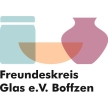
The factory during the 1930s-40s (exact date unknown) Photo: Elisabeth Pophal
The First World War brought about a considerable change for the prosperous glass factory Noelle & von Campe. Large numbers of the employees were conscripted, business abroad dried up and coal became scarce. In 1917, it was decided to establish a close cooperation with the neighbouring competitor, the Georgshütte, using its production equipment.
Hardly any improvements occurred in the years immediately after the war, partial factory closures were typical for the not so golden 1920s. The glass factory was threatened with bankruptcy during the World Economic Crisis. Noelle Brothers in Lüdenscheid went bankrupt and consequently the Noelle family could not continue its activities in Boffzen. In 1931, the whole work force of more than 120 people had to be sacked, the glass furnace was switched off and the factory was shut down between 1931 and 1934.

Automation began in the mid-1930s resulting in the steady loss of jobs for the glass blowers Photo: Elisabeth Pophal
However, after this period there was a decade of constant growth. Noelle & von Campe was a prestigious project for the job creation policy of the Nazi regime. Regional investors, citizens from Boffzen and Höxter and the von Campe family managed to generate in 1934 sufficient capital to reestablish the company. The economical recovery and the massive rearmament policy from 1936 onwards resulted in well-filled order books and growing profits. The production processes were modernised and partially automated. Bottles, packaging glass and glass bottling jars in general were the main products. The Second World War resulted in further conscription of the workers. But raw materials were still available, and glass products for the war effort were urgently needed. Noelle & von Campe employed forced labour from Ukraine, Czechia and Slovakia. Military goods were produced, from 1944 onwards, glass land mines. The glass factory was not damaged by air attacks and could consequentIy continue production after 1945 and increased its profitability steadily until 1953. Afterwards the glass market changed rapidly and Noelle & von Campe reacted to these changes by enhanced automation.

Share certificate from 1934 issued to the Association for the Social Interests of Boffzen by Noelle & von Campe Photo: Archive Glass Museum Boffzen
